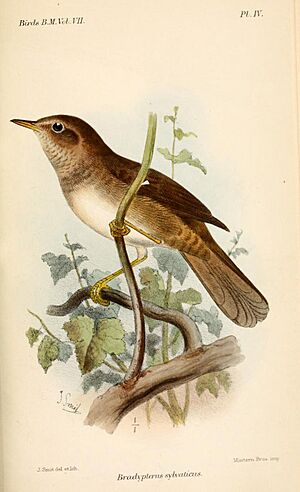Knysna warbler facts for kids
Quick facts for kids Knysna warbler |
|
|---|---|
 |
|
| Illustration by Joseph Smit, 1883 | |
| Conservation status | |
| Scientific classification | |
| Genus: |
Bradypterus
|
| Species: |
sylvaticus
|
The Knysna warbler (also called the Knysna scrub warbler) is a small, shy bird. Its scientific name is Bradypterus sylvaticus. This bird is only found in the coastal areas of South Africa. It is quite hard to spot because it likes to stay hidden.
The number of Knysna warblers is small and seems to be getting even smaller. This is mainly because their homes (habitats) are being broken up into smaller pieces. This happens both naturally and because of human activities. Also, these birds don't move around much and don't have many babies, which makes it harder for their population to grow.
Contents
What Does the Knysna Warbler Look Like?
The Knysna warbler is mostly brown. Its back, wings, and tail have a slightly green-brown (olivaceous) color. Its belly is a lighter brown, becoming almost white in the middle.
The chin and throat are also brownish, but they have white spots and thin stripes. The bird has a fairly short, square-shaped tail. Its eyes, beak, legs, and feet are brown. The lower part of its beak is a lighter, horn-like color.
Where Does the Knysna Warbler Live?
Knysna warblers love to live in thick, tangled bushes and plants. They are often found at the edges of forests, usually close to the coast. They have even learned to live in thickets of non-native bramble (a type of thorny bush). They can also be found in suburban areas near rivers, but they haven't spread much beyond their usual range.
You can find these birds along the coasts of the southern Western Cape and Eastern Cape provinces in South Africa. They are also found a little bit in KwaZulu-Natal. Sadly, they are no longer found near Durban because their habitat was destroyed there.
A small group of fewer than 40 pairs lives on the eastern side of Table Mountain in Cape Town. They also live in the forest valleys of the Langeberg mountains. Knysna warblers have been seen in about 24 nature reserves, including the Addo Elephant National Park.
How Does the Knysna Warbler Behave?
This bird stays very close to the ground, hidden in thick plants. Because it is so shy, it's very hard to see. It often looks for food on the ground.
The Knysna warbler has a special call that sounds like "tabirr." It also has a fine, fast, trilling song. If you play its song, you might be able to get it to come out of hiding.
Reproduction and Life Cycle
Most Knysna warblers build their nests in thick plants near streams. Their nests are placed very close to the ground. These birds tend to stay in the same area where they were born. For example, one young bird was seen a year later living in its parents' territory. Sometimes, they might move short distances from one place to another.
Similar Species
The Knysna warbler is similar to another bird called the Barratt's warbler. The Barratt's warbler lives further north. It has a slightly longer tail and a spotted throat. Its call and song are also different from the Knysna warbler's.


